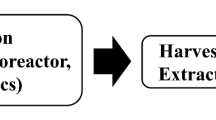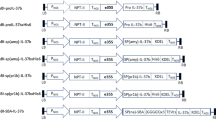Abstract
The production of pharmaceutical proteins in plants is creating a broad spectrum of new high-value traits in traditional crop species. As the production of these recombinant proteins moves from bench to field scale, containment and the presence of unwanted secondary metabolites are significant practical issues. We have developed a hybrid male-sterile low-alkaloid tobacco (MSLA) production platform. Recombinant protein is produced in leaves that are harvested prior to flowering. If considered for direct in vivo mammalian use the low-alkaloid background genotype addresses concerns about nicotine, and male sterility further reduces the risk of gene leakage. We have applied this system to the production of human interleukin-10 (phIL-10), a contra-inflammatory cytokine with potential application in the treatment of inflammatory bowel disease and autoimmune diseases. Transgenic low-alkaloid tobacco lines properly assembled a biologically active phIL-10 homodimer. Hybrids made by crossing a single homozygous high-expressing phIL-10 line with a MSLA female were field tested in a high density production system and harvested after 30 days. Recombinant phIL-10 yields were found to be similar in the hybrids and the homozygous control. MSLA tobacco is a practical, self-contained system for the production of plant recombinant proteins.
Similar content being viewed by others
References
Artsaenko O., Kettig B., Fiedler U., Conrad U. and During K. 1998. Potato tubers as a biofactory for recombinant antibodies. Mol. Breed. 4: 313–319.
Bai D., Reeleder R. and Brandle J.E. 1996. Production and characterization of tobacco addition lines carrying Nicotiana debneyi chromosomes with a gene for resistance to black root rot. Crop Sci. 36: 852–857.
Batteux F., Trebeden H., Charreire J. and Chiocchia G. 1999. Curative treatment of experimental autoimmune thyroiditis by in vivo administration of plasmid DNA coding for interleukin-10. Eur. J. Immunol. 29: 958–963.
Bradford M.M. 1976. A rapid and sensitive method for the quantitation of microgram quantities of protein utilizing the principle of protein-dye binding. Anal. Biochem. 72: 248–254.
Chen C.Y. and Shyu A.B. 1995. AU-rich elements: characterization and importance in mRNA degradation. Trends Biochem. Sci. 20: 465–470.
Court W.A., Brandle J.E., Pocs R. and Hendel J.G. 1992. The chemical composition of somatic hybrids between Nicotiana tabacum and Nicotiana debneyi. Can. J. Plant Sci. 72: 209–215.
Cramer C.L., Boothe J.G. and Oishi K.K. 1999. Transgenic plants for therapeutic proteins: linking upstream and downstream strategies. Curr. Top. Microbiol. Immunol. 240: 95–118.
Fiorentino D.F., Zlotnik A., Mosmann T.R., Howard M. and O'Garra A. 1991. IL-10 inhibits cytokine production by activated macrophages. J. Immunol. 147: 3815–3822.
Fischer R., Schumann D., Zimmermann S., Drossard J., Sack M. and Schillberg S. 1999. Expression and characterization of bispecific single-chain Fv fragments produced in transgenic plants. Eur. J. Biochem. 262: 810–816.
Gesser B., Leffers H., Jinquan T., Vestergaard C., Kirstein N., Sindet-Pedersen S. et al. 1997. Identification of functional domains on human interleukin 10. Proc. Natl. Acad. Sci. USA 94: 14620–14625.
Hood E.E., Witcher D.R., Maddock S., Meyer T., Baszczynski C., Bailey M. et al. 1997. Commercial production of avidin from transgenic maize: characterization of transformant, production, processing, extraction and purification. Mol. Breed. 3: 291–306 (1997).
Howard M., Muchamuel T., Andrade S. and Menon S 1993. Interleukin 10 protects mice from lethal endotoxemia. J. Exp. Med. 177: 1205–1208.
Kay R., Chan A., Daly M. and McPherson J. 1987. Duplication of CaMV 35S promoter sequences creates a strong enhancer for plant genes. Science 236: 1299–1302.
Kramer K.J., Morgan T.D., Throne J.E., Dowell F.E., Bailey M. and Howard J.A. 2000. Transgenic avidin maize is resistant to storage insect pests. Nature Biotechnol. 18: 670–674.
Kusnadi A.R., Nikolov Z.L. and Howard J.A. 1997. Production of recombinant proteins in transgenic plants: practical considerations. Biotechnol. Bioeng. 56: 473–484.
Leach M.W., Davidson N.J., Fort M.M., Powrie F. and Rennick D.M. 1999. The role of IL-10 in inflammatory bowel disease: ‘Of mice and men’. Toxicol. Path. 27: 123–133.
Legg P.D. and Collins G.B. 1971. Inheritance of per cent total alkaloids in Nicotiana tabacum L. II. Genetic effects of two loci in Burley 21 X LA Burley 21 populations. Can. J. Genet. Cytol. 13: 287–291.
LewisM.J. and Pelham H.R. 1990. A human homologue of the yeast HDEL receptor. Nature 348: 162–163.
Ma J.K., Hiatt A., Hein M., Vine N.D., Wang F., Stabila P. et al. 1995. Generation and assembly of secretory antibodies in plants. Science 268: 716–719.
Ma S.W., Zhao D.L., Yin Z.Q., Mukherjee R., Singh B., Qin H.Y. et al. 1997. Transgenic plants expressing autoantigens fed to mice to induce oral immune tolerance. Nature Med 3: 793–796.
Ma J.K., Hikmat B.Y., Wycoff K., Vine N.D., Chargelegue D., Yu L. et al. 1998. Characterization of a recombinant plant monoclonal secretory antibody and preventive immunotherapy in humans. Nature Med. 4: 601–606.
Miele L. 1997. Plants as bioreactors for biopharmaceuticals: regulatory considerations. Trends Biotechnol. 15: 45–50.
Miki B., McHugh S.G., Labbe H., Ouellet T., Tolman J.H. and Brandle J.E. 1999. Transgenic tobacco: gene expression and applications. Biotechnol. Agric. For. 45: 336–354.
Mire-Sluis A.R. 1999. Cytokines: from technology to therapeutics. Trends Biotechnol 17: 319–325.
Moore K.W., O'Garra A., de Waal-Malefyt R., Vieira P. and Mosmann T.R. 1993. Interleukin-10. Annu. Rev. Immunol. 11: 165–190.
Napier R.M., Fowke L.C., Hawes C., Lewis M. and Pelham H.R. 1992. Immunological evidence that plants use both HDEL and KDEL for targeting proteins to the endoplasmic reticulum. J. Cell. Sci. 102: 261–271.
Ohme-Takagi M., Taylor C.B., Newman T.C. and Green P.J. 1993. The effect of sequences with high AU content on mRNA stability in tobacco. Proc Natl. Acad. Sci. USA 90: 11811–11815.
Parmenter D.L., Boothe J.G., van Rooijen G.J., Yeung E.C. and Moloney M.M. 1995. Production of biologically active hirudin in plant seeds using oleosin partitioning. Plant Mol. Biol. 29: 1167–1180.
Pauza M.E., Neal H., Hagenbaugh A., Cheroutre H. and Lo D. 1999. T-cell production of an inducible interleukin-10 transgene provides limited protection from autoimmune diabetes. Diabetes 48: 1948–1953.
Pretolani M. and Goldman M. 1997. IL-10 a potential therapy for allergic inflammation? Immunol. Today 18: 277–280.
Reich K., Bruck M., Grafe A., Vente C., Neumann C. and Garbe C. 1998. Treatment of psoriasis with interleukin-10. J. Invest. Dermatol. 111: 1235–1236.
Schouten A., Roosien J., van Engelen F.A., deJong G.A.M., Borst-Vrenssen A.W.M., Zilverentant J.F. et al. 1996. The C-terminal KDEL sequence increases the expression level of a single-chain antibody designed to be targeted to both the cytosol and the secretory pathway in transgenic tobacco. Plant Mol. Biol. 30: 781–793.
Spangenberg G., Perez V.R., Oliveira M.M., Osusky M., Nagel J., Pais M.S. et al. 1992. CMS system in Nicotiana: flower development, patterns of mitochondrial DNA and mitochondrial gene expression. I. Analysis of parental Nicotiana spp. and alloplasmic cms analogs of tobacco. Sex. Plant Reprod. 5: 13–26.
Sproule A., Donaldson P., Dijak M, Bevis E., Pandeya R., Keller W.A. et al. 1991. Fertile somatic hybrids between transgenic Nicotiana tabacum and transgenic Nicotiana debneyi selected by dual-antibiotic resistance. Theor. Appl. Genet. 82: 450–456.
Thompson-Snipes L., Dhar V., Bond M.W., Mosmann T.R., Moore K.W. and Rennick D.M. 1991. Interleukin-10: a novel stimulatory factor for mast cells and their progenitors. J. Exp. Med. 173: 507–510.
van den Elzen P.J.M., Townsend J., Lee K.Y. and Bedbrook J.R. 1985. A chimeric hygromycin resistance gene as a selectable marker in plant cells. Plant Mol. Biol. 5: 299–302.
van Rooijen G.J. and Moloney M.M. 1995. Plant seed oil-bodies as carriers for foreign proteins. Bio/technology 13: 72–77.
Vellekamp G., Cannon-Carlson S. and Tang J. 1994. Purification of human interleukin-10 from a cell culture medium. US Patent 5,328,989.
Vellekamp G., Cannon-Carlson S. and Tang J. 1998. Purification of bacterially expressed human interleukin-10. US Patent 5,710,251.
Vieira P., de Waal-Malefyt R., Dang M.N., Johnson K.E., Kastelein R., Fiorentino D.F. et al. 1991. Isolation and expression of human cytokine synthesis inhibitory factor cDNA clones: homology to Epstein-Barr virus open reading frame BCRFI. Proc. Natl. Acad. Sci. USA 88: 1172–1176.
Wilcox C.P., Weissinger A.K., Long R.C., Fitzmaurice L.C., Mirkov T.E. and Swaisgood H.E. 1997. Production and purification of an active bovine lysozyme in tobacco (Nicotiana tabacum): utilization of value-added crop plants traditionally grown under intensive agriculture. J. Agric. Food Chem. 45: 2793–2797.
Windsor W.T., Syto R., Tsarbopoulos A., Zhang R., Durkin J., Baldwin S. et al. 1993. Disulfide bond assignments and secondary structure analysis of human and murine interleukin-10. Biochemistry 32: 8807–8815.
Woodlief W.G., Chaplin J.F., Campbell C.R. and DeJong D.W. 1981. Effect of variety and harvest treatments on protein yield of close-grown tobacco. Tobacco Sci. 25: 83–86.
Zdanov A., Schalk-Hihi C., Gustchina A., Tsang M., Weatherbee J. and Wlodawer A. 1995. Crystal structure of interleukin-10 reveals the functional dimer with an unexpected topological similarity to interferon gamma. Structure 3: 591–601.
Zheng X.X., Steele A.W., Nickerson P.W., Steurer W., Steiger J. and Strom T.B. 1995. Administration of noncytolytic IL-10/Fc in murine models of lipopolysaccharide-induced septic shock and allogeneic islet transplantation. J. Immunol. 154: 5590–5600.
Author information
Authors and Affiliations
Rights and permissions
About this article
Cite this article
Menassa, R., Nguyen, V., Jevnikar, A. et al. A self-contained system for the field production of plant recombinant interleukin-10. Molecular Breeding 8, 177–185 (2001). https://doi.org/10.1023/A:1013376407362
Issue Date:
DOI: https://doi.org/10.1023/A:1013376407362




